The greatest weakness in America's amphibious warfare capability
is a lack of ships to stealthily put armored combat vehicles ashore.
Rather than waste money on the AAAV "amtrack" to charge from the sea
at high speeds, the Marine Corps should
fund a Landing Ship Barge (LSB), which would be a hybrid of existing LSTs and
LCUs.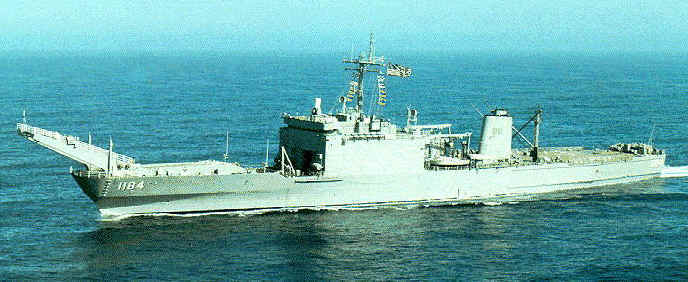 This craft would sneak to the shore at night or in fog by moving silently
and nearly underwater.
This craft would sneak to the shore at night or in fog by moving silently
and nearly underwater.
General Characteristics, Newport class LST
Power plant: Six diesels, two shafts, 16,000 hpLength: 522 feet (156.6 meters)
Beam: 69 feet (20.7 meters)
Displacement: 8,450 tons (8,585.61 metric tons) full load
Speed: 20 knots (23 mph, 36.8 kph)
Crew: 13 officers, 244 enlisted
Armament: One 20 mm Phalanx CIWS mount; two 25 mm MK 38 machine guns
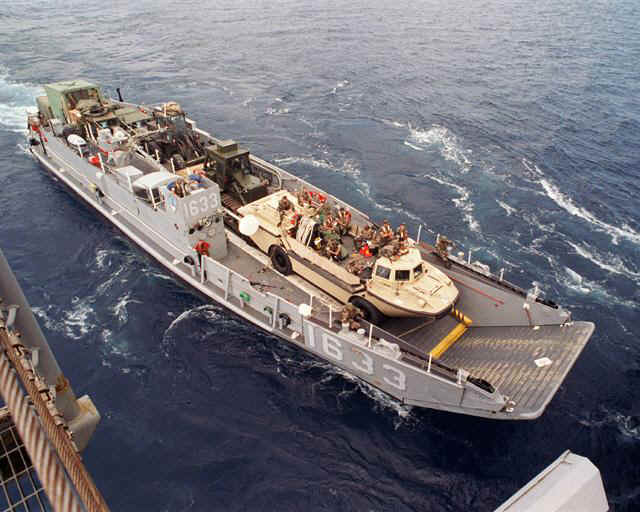 Capacity: 29 tanks and over 350 troops
Capacity: 29 tanks and over 350 troops
General Characteristics, LCU
Power Plant:2- Detroit 12V-71 Diesel engines, twin shaft, 680 hp sustained, Kort nozzlesLength: 134.9 feet (41.1 meters)
Beam: 29 feet (8.8 meters)
Displacement: 200 tons (203.21 metric tons) light; 375 tons (381.02 metric tons) full load
Speed: 11 kts (12.7 mph, 20.3 kph)
Range: 1200 miles at 8 knots
Capacity: 170 tons (172.73 metric tons)
Military Lift: 125 tons of cargo
Crew: 14
Guns: 2- 12.7mm MGs
Radar: Navigation: LN 66 or SPS-53; I band.
The LCU is too small to carry a useful load at 134 feet in length, while the LST too big a target at 522 feet. Build a ship similar to the LST but only 300 feet long, and eliminate the highly visible superstructure so it looks like a huge LCU. The ship would have a roll-on roll-off lower deck like a ferry, and a flat open upper deck like an aircraft carrier. For non-combat transport missions, it could carry cargo below deck and on its "flattop" which is ideal for stacking large commercial cargo boxes. The flat deck could also be used to rearm and refuel helicopters and VSTOL aircraft if a forward point is needed up a river or inlet.
The US Army already has similar ships, called Logistics Support Vessels (LSV) which provide worldwide transport of general and vehicular cargo. LSV missions include intra-theater line-haul in support of unit deployment or relocation; tactical and sustained resupply to remote, undeveloped areas along coastlines, and support to the discharge and backload of ships in RORO or LOTS operations. .
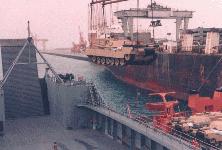
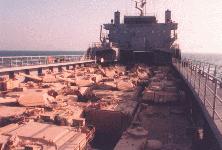
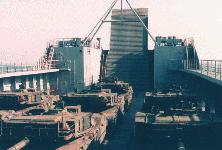
- Length (overall): 273 feet.
- Beam (molded): 60 feet.
- Displacement (weight): 4,199 LTONs.
- Deck area: 10,500 square feet (21 to 24 M1 main battle tanks or 25 [50 double-stacked] 20-foot ISO containers).
- Bow ramp opening: 26 feet wide.
- Payload: 2,000 STONs (86 C-141 loads).
- Range: 8,200 nautical miles at 12.5 knots (light); 6,500 nautical miles at 11.5 knots (loaded).
- Draft: 6 feet (light); 12 feet (loaded).
- Drive-through capability (bow and stem ramps).
- Self-delivery range: 6,500 nautical miles.
- Sustains crew of 6 officers and 23 enlisted personnel for up to 30 days.
- Transports heavy, outsized cargo including rolling stock, general cargo, and ISO containers.
The real value of LSBs will be their value to sneak up to shore and disgorge a dozen armored vehicles. The sides of the ship will be angled to deflect radar and coated with radar absorbing black paint. It will have a diesel-electric engine common on submarines. This will allow the LSB to switch to electric so it can move without sound or infra-red signature. During stealth missions, nothing is carried on deck as the ship takes on ballast to sink as low as one foot above the water, depending on wave conditions. The ramp to the lower deck can close so the ship is water tight and will not sink if water rushes across. Even if visually spotted, radar and infra-red guided guns or missiles will be unable to lock-on to an LSB, and shore gunners will find it difficult to hit these low targets with only feint visual references. It may be possible to build a submersible LSB that can submerge a few feet below the surface like a submarine, but that may be too expensive.
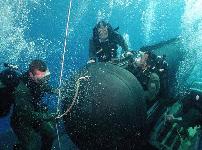 However, an battery-powered LSB cruising slowly a foot above the water will be almost
impossible to locate at night or in daytime fog. This would allow several
LSBs to deliver a powerful landing force on an enemy shore completely
undetected, especially since the enemy will be ducking naval gunfire and air
attacks as the LSBs slowly sneak toward shore. Navy SEALs and Marine recon
divers will have already checked each LSBs path for mines and obstacles and
removed threats. They will also have found the ideal landing points with
the best gradient to match the offload ramp. The LSBs can use GPS navigation
and bow thrusters to stay exactly on the planned course with Navy SEALs leading
the way in a small underwater delivery vehicles. (above)
However, an battery-powered LSB cruising slowly a foot above the water will be almost
impossible to locate at night or in daytime fog. This would allow several
LSBs to deliver a powerful landing force on an enemy shore completely
undetected, especially since the enemy will be ducking naval gunfire and air
attacks as the LSBs slowly sneak toward shore. Navy SEALs and Marine recon
divers will have already checked each LSBs path for mines and obstacles and
removed threats. They will also have found the ideal landing points with
the best gradient to match the offload ramp. The LSBs can use GPS navigation
and bow thrusters to stay exactly on the planned course with Navy SEALs leading
the way in a small underwater delivery vehicles. (above)
As each LSB touches down, it pumps out ballast to rise higher
and drops a ramp as tanks and other combatants race forward onto the beach.
LSBs will pop out of the ocean like a huge alligator and disgorge its armored vehicles
directly into combat within in a minute, then slide back
into the water.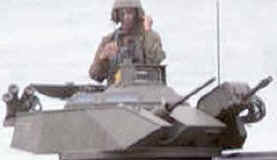 The bow may have tracks like a bulldozer allowing it to pull itself on shore and push
itself off. LSBs will have a small forward gun turret on each
side, perhaps those now used on Marine Corps
amtracks which mount both a .50cal and 40mm gun. They will provide suppressive
fire on the beach as the bulletproof LSB touches down, then backs out to sea a
minute later.
The bow may have tracks like a bulldozer allowing it to pull itself on shore and push
itself off. LSBs will have a small forward gun turret on each
side, perhaps those now used on Marine Corps
amtracks which mount both a .50cal and 40mm gun. They will provide suppressive
fire on the beach as the bulletproof LSB touches down, then backs out to sea a
minute later.
An LSB can use its ramp to pick up cargo from the well-decks of large amphibious ships, or from nearby staging areas. The LSB will be a seagoing vessel, like the LCU, with a small crew of about 20. Its square design may limit speeds to 15 knots, and its small crew and austere accommodations are not suited to six-month peacetime deployments overseas. Therefore, half of LSBs may be based overseas to provide rapid theater support. A couple on Okinawa or Sasebo, Japan would be ideal to move Marines around the Pacific. Navy bases at Bahrain in Persian Gulf and in Italy are also good candidates to forward base LSBs. They will look and function like commercial barges in peacetime so locals will hardly notice them. During wartime, enemy defenders will fail to notice them until they pop out of the water like an attacking alligator.
Carlton Meyer editorG2mil@Gmail.com
©2002 www.G2mil.com